- Binding : Paperback
- Publisher : Taxmann
- Author : V.S. Datey
- Edition : July 2024
- Language : English
- ISBN-10 : 9789357789523
- ISBN-13 : 9789357789523
Taxmann’s Insolvency and Bankruptcy Code Ready Reckoner by V.S. Datey – Edition 2024
₹1,495.00 Original price was: ₹1,495.00.₹1,121.00Current price is: ₹1,121.00.
Taxmann’s Insolvency and Bankruptcy Code Ready Reckoner by V.S. Datey – Edition July 2024. This book provides a topic-wise commentary on the Insolvency and Bankruptcy Code, 2016 (IBC), along with references to the Recovery of Debts and Bankruptcy Act, 1993, and the SARFAESI Act, 2002. The book addresses practical challenges professionals face and provides detailed and cross-referenced analysis of 25+ crucial topics within the IBC. It also includes a subject index for easy navigation.
10 in stock
Taxmann’s Insolvency and Bankruptcy Code Ready Reckoner by V.S. Datey – Edition July 2024.
Taxmann’s Insolvency and Bankruptcy Code Ready Reckoner by V.S. Datey – Edition July 2024.
Description
This book offers a comprehensive and detailed commentary on Insolvency and Bankruptcy laws in India, organised by topic for ease of reference. It encompasses an in-depth analysis of the following key legislations:
- Insolvency and Bankruptcy Code, 2016 (IBC)
- Recovery of Debts and Bankruptcy Act, 1993
- Securitisation and Reconstruction of Financial Assets and Enforcement of Securities Interest Act, 2002 (SARFESI Act)
This book addresses the practical challenges that professionals encounter routinely, offering precise and complete information on all Insolvency and Bankruptcy law provisions. It is crafted to be an indispensable resource for a wide range of professionals and scholars, including:
- Legal Professionals and Corporate Lawyers
- Chartered Accountants and Financial Experts
- Company Secretaries and Cost Management Accountants
- Academics and Students in Law and Finance
The Present Publication is the July 2024 Edition, authored by V.S. Datey. It is amended upto 10th June 2024 with the following noteworthy features:
- [Topic-wise Commentary on 25+ Topics] The book provides a detailed and insightful commentary on more than 25 crucial topics within the Insolvency and Bankruptcy Code. Each topic is thoroughly examined to give a comprehensive understanding
- [Cross-referenced Analysis] This book features a cross-referenced analysis that links the IBC with pertinent Rules and Regulations, Judicial Pronouncements, Circulars, and Notifications. This approach ensures that readers have a holistic view and can understand the interconnections and implications of various legal provisions
- [Subject Index for Easy Navigation] The book includes a subject index to facilitate seamless navigation and quick reference. This index is designed to help readers easily locate specific topics and provisions, thereby enhancing the usability and accessibility of the content
The contents of the book are as follows:
- Declining Stage of an Organisation
- This chapter discusses the early signs of organisational decline, the overall scheme of the Insolvency and Bankruptcy Code, its overriding effect over other laws, and the applicability of the Limitation Act in insolvency proceedings before NCLT or NCLAT. It also covers relevant provisions of the Companies Act, the role and functions of the Insolvency and Bankruptcy Board of India (IBBI), adjudicating authorities, and Information Utilities (IU). Additionally, it analyses the Insolvency and Bankruptcy Fund, revamped winding-up provisions, transitory provisions for shifting from winding-up to insolvency, and lenders’ options under SARFAESI and DRT
- Insolvency Professional
- This chapter provides an in-depth look at the roles and regulations for insolvency professionals, including the Insolvency Professional Agency (IPA), the qualifications and responsibilities of Insolvency Professionals (IP), the panel of insolvency professionals recommended to NCLT as Interim Resolution Professionals or Liquidators, and Insolvency Professional Entities
- Insolvency Resolution of Corporate Persons
- The chapter details the procedures and legal requirements for initiating and conducting the Corporate Insolvency Resolution Process (CIRP). It covers initiation by financial creditors, operational creditors, and corporate applicants, special provisions for real estate projects, and initiation against corporate or personal guarantors. It also elaborates on the appointment of Interim Resolution Professionals, subsequent procedures before NCLT, and conditions for withdrawing an application after admission
- Conducting Corporate Insolvency Resolution Process
- This chapter guides readers through the CIRP stages, including the declaration of moratorium, public announcements, appointment and tenure of interim resolution professionals, submission of proof of claims, and the formation and functions of the Committee of Creditors (CoC). It also discusses the powers and duties of resolution professionals, preparation of information memorandums, and protections for insolvency resolution professionals regarding previous transactions. Special provisions for Non-Banking Financial Companies (NBFCs) with assets of Rs. 500 crore or more are included
- Resolution Plan by Resolution Applicant
- This chapter outlines the submission, evaluation, approval, and implementation of resolution plans. It covers ineligible resolution applicants, invitations for expression of interest, submission of resolution plans, insolvency resolution process costs, approval by the CoC, and submission of the plan to the Adjudicating Authority. It also discusses the assistance of district administration in implementing the resolution plan, the effects of the resolution plan being rejected by NCLT, appeal mechanisms, immunity from prosecution, and protections against actions related to offences committed before the CIRP
- Fast Track Corporate Insolvency Resolution Process
- This chapter provides a focused look at the fast-track process designed for quicker resolution of insolvency cases under specific conditions, detailing the application and procedural steps
- Pre-Packaged Insolvency Resolution Process (PPIRP)
- This chapter introduces the Pre-Packaged Insolvency Resolution Process (PPIRP), including its background, design, application provisions, priority over CIRP, eligibility criteria, and initiation process by corporate debtors. It elaborates on the duties and authorities of the proposed Insolvency Professional, procedural steps before application, filing and admission of applications by the Adjudicating Authority, and the moratorium during the PPIRP period
- Procedure for PPIRP After Admission of Application
- This chapter covers the formal process of PPIRP post-admission, including the conduct of PPIRP by the Resolution Professional, powers during the initial stages, filing applications for avoidance of transactions, seeking prior approval from the CoC, and information requirements from financial institutions. It discusses the submission and updating of claims, the conduct of business during PPIRP, the constitution and functioning of the CoC, and meetings within the PPIRP framework
- Submission and Approval of Resolution Plan under PPIRP
- This chapter explains what constitutes a resolution plan, the submission of the base resolution plan by the Resolution Professional to the CoC, the invitation to other applicants if the base plan is not approved, the provision of information to resolution applicants, the evaluation of submitted plans, and the final approval process by the Adjudicating Authority. It also addresses the termination of PPIRP leading to liquidation and conditions for shifting from PPIRP to CIRP
- Liquidation of Corporate Persons
- This chapter covers the initiation of liquidation, appointment and fees of liquidators, their powers and duties, the liquidation estate, realisation of security interests, distribution of unsold assets, and liabilities of contributors in liquidation
- Admission and Proof of Claims by Liquidator
- The chapter discusses the powers of liquidators to access information, ascertain claims, avoid preferential and undervalued transactions, and take actions to protect against excessive credit transactions. It also covers the position of secured creditors in liquidation proceedings
- Realisation and Distribution of Assets by Liquidator
- This chapter details the realisation and mode of asset sales by liquidators, the payment protocols, the distribution of cash to stakeholders, the completion of liquidation within a specified timeframe, the final report by liquidators before dissolution, and the transfer of unclaimed proceeds to the Corporate Liquidation Account
- Payment of Dues to Stakeholders After Liquidation or During Formulation of Resolution Plan
- This chapter provides guidelines on the priority and distribution of assets, trust-held money, statutory dues, workers’ dues, secured creditors’ provisions, tax dues priority, and preferential payments. It also covers the distribution of surplus amounts to members and tax liabilities related to asset distribution
- Voluntary Liquidation of Companies
- The procedures and legal requirements for voluntary liquidation initiated by companies with no default, notification to the Registrar, application to NCLT, and realisation of assets are discussed in this chapter
- Adjudication and Appeals for Corporate Persons
- This chapter provides insights into the adjudication process, appeal mechanisms, jurisdiction of NCLT and IBBI, expeditious disposal of applications, and penalties for fraudulent or malicious initiation of proceedings.
- Cross Border Insolvency and Bankruptcy
- The complexities and legal considerations in cross-border insolvency cases, including enabling provisions, agreements with foreign countries, and letters of request for assets outside India, are discussed in this chapter
- Offences and Penalties in Relation to Corporate Insolvency
- This chapter details the punishments for various offences related to insolvency, including concealment of property, transactions defrauding creditors, misconduct during the insolvency process, falsification of books, false representations, and non-disclosure of disputes or payments
- Bankruptcy for Individuals and Partnership Firms
- This chapter comprehensively covers the bankruptcy processes applicable to individuals and partnership firms, including roles of adjudicating authorities, jurisdiction of civil courts, and appeal mechanisms
- Fresh Start Process
- The chapter provides an overview of the fresh start process, offering relief for individuals burdened by insolvency, detailing eligibility criteria, interim moratorium, procedural steps, creditor objections, and discharge orders
- Insolvency Resolution of Individual and Firm
- This chapter guides readers through the insolvency resolution process for individuals and firms, including initiation of the process, interim moratorium, adjudicating authority decisions, registration of claims, debtor’s repayment plan, creditor meetings, and rights of secured creditors
- Bankruptcy Order for Individuals and Firms
- This chapter provides detailed instructions on obtaining and implementing bankruptcy orders for individuals and partnership firms, including interim moratoriums, bankruptcy orders by adjudicating authorities, financial position statements, claim settlements, estate administration, discharge orders, and bankruptcy process modifications or recalls.
- Bankruptcy Trustee
- This chapter analyses the role and responsibilities of bankruptcy trustees in managing bankrupt estates, including obtaining creditor approval for certain actions, managing disclaimed properties, and dealing with undervalued or extortionate credit transactions
- Settlement of Claims Against Bankrupt
- This chapter provides the guidelines for the settlement of claims against bankrupt individuals or firms, including proof of debt, interim and final dividend distributions, and priority of payments
- Compromises, Arrangements, and Amalgamations
- This chapter discusses legal provisions and procedures for compromises, arrangements, and amalgamations, including applications to NCLT, merger and amalgamation processes, simplified fast-track procedures for small companies, cross-border mergers, and compulsory amalgamations ordered by the Central Government
- Registered Valuers
- This chapter covers the qualifications, registration, and roles of registered valuers and their liability as experts.
- Removal of Name of Companies from Register of Members
- This chapter details the procedures for removing company names from the register, including the process for striking off, voluntary removal requests, winding-up orders by NCLT, restrictions on applying for name removal, and the effects of dissolution
- NCLT and NCLAT
- This chapter provides comprehensive coverage of the roles and functions of the National Company Law Tribunal (NCLT) and the National Company Law Appellate Tribunal (NCLAT), including procedural aspects and appeals to the Supreme Court
- Recovery of Debts and Bankruptcy Act, 1993
- This chapter provides an in-depth analysis of the Recovery of Debts and Bankruptcy Act, 1993, focusing on the procedures of the Debt Recovery Tribunal (DRT) and Debt Recovery Appellate Tribunal (DRAT), appeals, and recovery powers
- SARFAESI Act
- This chapter examines the Securitisation and Reconstruction of Financial Assets and Enforcement of Securities Interest Act, 2002 (SARFAESI Act), including enforcement of security interest, procedures for asset sale, management takeover of defaulting borrowers, applications, appeals, penalties, securitisation, roles and functions of Asset Reconstruction Companies (ARCs), and the Central Registry
- RBI Directions on Resolution of Stressed Assets
- This chapter covers the Reserve Bank of India’s (RBI) directions on the resolution of stressed assets, including the prudential framework, implementation timelines, provisioning norms for delayed resolution plans, supervisory review by the RBI, disclosures by lenders in financial statements, and exceptions to the stressed asset resolution directions.
Details
| Publisher | |
|---|---|
| Author | |
| Language |
Be the first to review “Taxmann’s Insolvency and Bankruptcy Code Ready Reckoner by V.S. Datey – Edition 2024” Cancel reply
Related products
GST
Bharat’s How to handle GST Audit with real life case studies by CA. Arun Chhajer – 1st Edition 2023
MSME
Bloomsbury’s Treatise on Micro, Small and Medium Enterprises by Rajeev Babel – 1st Edition June 2021


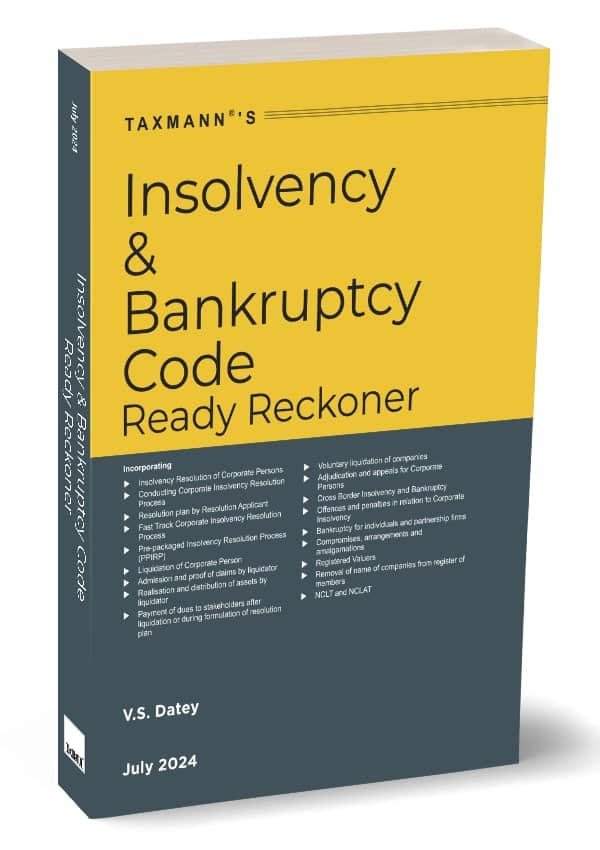


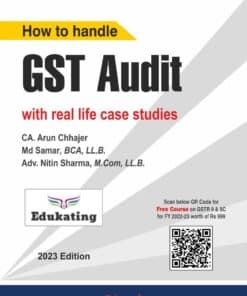
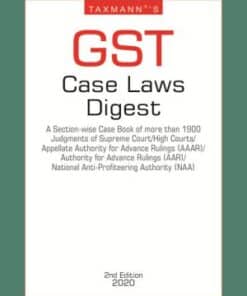

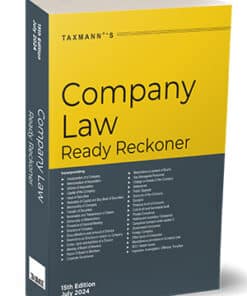
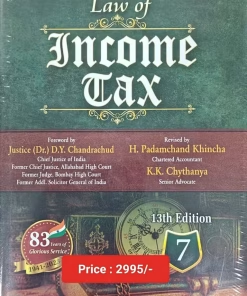
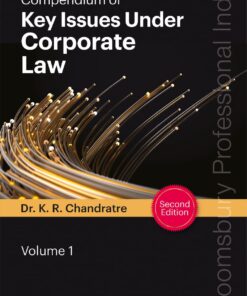
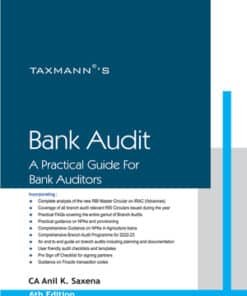
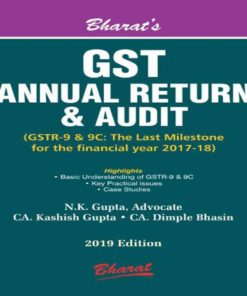
Reviews
There are no reviews yet.